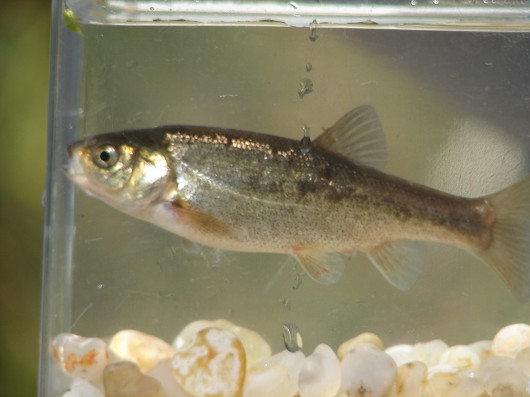Arroyo Chub
-
Scientific NameGila orcutti
-
NativeNative Species
-
Identification
 Arroyo chub. Captured from San Antonio Creek (Vandenberg Air Force Base) in 2008. Photo by Carl Page, ARS Consulting.
Arroyo chub. Captured from San Antonio Creek (Vandenberg Air Force Base) in 2008. Photo by Carl Page, ARS Consulting.- Small chunky fish, up to 120 mm SL
- Deep body and caudal peduncle
- Large eyes, short round snout, small sub-terminal mouth
- Coloration: body is silver or gray to olive green on top, white underside, and dull gray lateral band
- Males have larger fins than females
- Breeding males develop patch of tubercles on upper surface of pectoral fins
- Fin rays: dorsal 8, anal 7
- Lateral line scales: 48-62
- Gill rakers: 5-9
- Pharyngeal teeth: typically 2,5-4,2
-
Life History
Arroyo chub are native to the streams and rivers of the Los Angeles plain in southern California, including the Los Angeles, San Gabriel, San Luis Rey, Santa Ana, and Santa Margarita Rivers, and Malibu and San Juan Creeks. They have been extirpated from much of their native range, but have been introduced to streams along the coast as far north as Chorro Creek in San Luis Obispo County. They have also been introduced to the Mojave River system where they have eliminated the Mojave tui chub. Arroyo chub are adapted to survive in cool to warm (10 – 24oC) streams that fluctuate between large winter storm flows, and low summer flows, and the low dissolved oxygen and wide temperature fluctuations associated with this flow regime. They are most common in slow flowing or backwater areas with sand or mud substrate, but may also inhabit areas with velocities in excess of 80 cm/s over coarse substrate. They feed on plants such as algae and water fern (Azolla), and on invertebrates such as insects and mollusks. Arroyo chubs reach a size of 80 - 90 mm by their fourth year and rarely live longer than this. Females can reproduce at age 1. Spawning takes place in pools and edge habitat from February to August with a peak in June and July. Several males may fertilize the eggs of one female. Fertilized eggs stick to plants or bottom substrate and hatch in about 4 days. Fry stay on the substrate for a few days, then rise to the surface and stay among plants or other cover for 3 – 4 months.
-
Links to Other ResearchN / A
-
Watershed
-
Aliso-San Onofre Watershed
-
Antelope-Fremont Valleys Watershed
-
Calleguas Watershed
-
Central Coastal Watershed
-
Cuyama Watershed
-
Los Angeles Watershed
-
Mojave Watershed
-
Newport Bay Watershed
-
San Antonio Watershed
-
San Diego Watershed
-
San Gabriel Watershed
-
San Jacinto Watershed
-
San Luis Rey-Escondido Watershed
-
Santa Ana Watershed
-
Santa Barbara Coastal Watershed
-
Santa Clara Watershed
-
Santa Margarita Watershed
-
Santa Maria Watershed
-
Santa Monica Bay Watershed
-
Santa Ynez Watershed
-
Seal Beach Watershed
-
Southern Mojave Watershed
-
Ventura Watershed
-
Please note, watersheds are at the USGS 8-digit Hydrologic Unit Code (HUC) scale, so they often include a lot of sub-watersheds. If a species occurs in any sub-watershed within the HUC, the species appears within the HUC. Link to an EPA page that shows HUCs.
